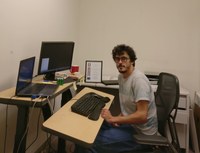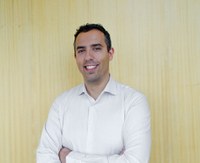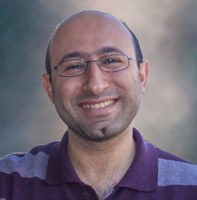Where are you now?
Every month INESC TEC sends highly qualified individuals into the market. These individuals often then go on to occupy important positions in some of the best national and international companies or they opt to form spin-offs. As the best way to perform technology transfer is through individuals, this section is dedicated to collaborators that trained at INESC TEC and now star in other companies and institutions.

MIGUEL HELENO, LAWRENCE BERKELEY NATIONAL LABORATORY, PoSt-DOC
- Year when you began working at INESC TEC and when you left: 2010-2016
- Centre at INESC TEC where you worked: CPES
- Name(s) of project(s) you were involved in: In addition to my master’s and doctoral theses, which were developed in collaboration with CPES, I had the chance to cooperate in several projects, from which I highlight MERGE (FP7), the first project, and AnyPLACE (H2020), the last.
Explain your experience since leaving INESC TEC
I left INESC TEC about a year and a half ago in order to do a postdoc in Berkeley, United States. The Lawrence Berkeley National Laboratory (LBNL) is very much like INESC TEC in terms of goals and the role they play in science and in technology transfer, as it is also a national laboratory based on public financing and at the same time with a close relation with the industry sector. A big difference is that the LBNL focuses more on scientific areas related to energy, from fundamental research in physics and chemistry, through matters regarding the environment, the weather and energy policies, to the development of technologies for application in buildings and energy networks. The other major difference is, obviously, the scale. As a reference laboratory in the USA, LBNL has more than 800 million dollars of annual funding, more than 3000 employees, 13 Nobel Prizes, a campus with 100 hectares, dozens of buildings and two bus lines to move internally. Anyway, it’s similar to what an American INESC TEC would look like!
At LBNL, my work is devoted mainly to the development of optimization algorithms for planning and operating microgrids. I am responsible for the technical component of projects financed by the Department of Energy and by the Department of Defense of the USA in the microgrid area, which involve investment analysis and distributed resources operation, as well as some regulatory aspects. I have had the opportunity to work with people from all over the world, with very diverse competences, who have taught me a lot and helped me become a better researcher.
ALI AZARIAN, CRITICAL SOFTWARE S.A., PROJECT ENGINEER
- Year when you began working at INESC TEC and when you left: 2012-2016
- Centre at INESC TEC where you worked: CSIG
Explain your experience since leaving INESC TEC
When I finished my Ph.D., I started a research project at the University of Minho in the field of IoT, which was not included in my previous field of research during the Ph.D. My first reason for moving to a different research field was that I was very interested in the domain of IoT and I had never gotten the opportunity to work in that area. The second reason was that I wanted to challenge myself and to see if I was able to do research on something new and absolutely out of the scope of my Ph.D. I started working on the INNOVECAR project and with BOSCH in Braga, which was involved in the project and provided us the IoT sensors required for the project. During my stay, I worked on sensor-based data acquisition approaches for road surface condition.
After this great experience, I decided to improve my engineering skills as an engineer in an embedded system, which is one of my research interests. I applied for the embedded system engineer position at Critical Software S.A., which is one of the most prestigious software companies in Portugal, and I started working on Space vehicle embedded software. At the beginning, it was a big challenge to adapt to the new industrial environment and engineering working mode coming from an academic setting. I was involved in Solar Orbiter project, which was part of the main Solar Orbiter project from the European Space Agency.
I am currently involved as a project engineer in the embedded system team at Critical Software S.A. and I am working on providing board support packages (BSPs) designed for automotive projects for clients such as Continental. In this position, it is our job to provide the BSPs codes that fit the different types of boards our clients have in order to work with our own real-time operating system, which our team developed.

PEDRO FORTUNA, JSCRAMBLER, FOUNDER & CTO
- Year when you began working at INESC TEC and when you left: As a master student, I started working at INESC TEC in 2005. In mid-2010, I stopped working full time at INESC TEC and gradually reduced my work until I left in 2016.
- Centre at INESC TEC where you worked: CTM
- Name(s) of project(s) you were involved in: WiMetroNet
Explain your experience since leaving INESC TEC
I bootstrapped Jscrambler in 2010 along with another co-founder. For years, we researched and developed technology concerned with finding fraudulent web traffic. We even did a QREN research project with INESC TEC (AuditService 2.0) on device tracking on the web.
However, in 2010 we started focusing on JavaScript code protection. We built a JavaScript formal compiler with a number of code transformations that aim to make the code resilient against tampering and reverse engineering attacks. We fully developed the technology and have been successfully selling it to some of the most well-known companies in the world in the last few years. More recently, we rolled out a new product for Website integrity where we can detect and remove any malicious modification to a website’s DOM. It was a huge investment and we are optimistic about taking it to the market.
During these last few years, I have been covering many different functions in the company: R&D coordination, business development, promulgation, sales, etc. My experience at INESC TEC was very helpful in mastering these responsibilities because, even though I did not have these responsibilities then, I brought the same type of mindset and culture to Jscrambler. It also helped me become a better communicator, which was essential in becoming a regular speaker at well-known security conferences.
Three patents (pending) resulted from our research. Again, I didn’t work on patents while at INESC TEC. I now know that it’s not an easy task. But we wouldn’t have a chance if we weren’t innovating. When you work at INESC TEC you are taught how to seek innovation and you more or less develop a sixth sense for it. That sixth sense has been fruitful.
It wasn’t a problem adjusting from an academic setting to a startup and industry environment because in the beginning it was just like a research group. The tough part was learning how to sell technology. Knowing how to commercialize technology well is a rare trait in researchers, and one that is hard to learn. Fortunately, our entrepreneurial ecosystem is becoming stronger, and it is now in a much better shape to help researchers create new startups. The University of Porto’s Technology and Science Park (UPTEC) and its Startup Program and the Scaleup Program of the Porto’s Municipality are excellent (and local) examples.
Today, my work focuses more on technology promulgation, product steering and R&D – and less on managing the daily life of a software development company. I spend a lot of time abroad, especially in the United States. As you scale a technology/innovation-focused company, you get the chance to learn a lot and to grow tremendously. You are permanently outside your comfort zone, and that’s great.



